The Pokémon TCG keeps growing. The recent Regional Championships in Charlotte were the biggest the game has experienced, with more than 2000 players in the TCG Masters category alone. It’s the perfect occasion to take a look at the metagame and talk about what we’ve learned and what has changed since Paradox Rift released. The format may be the same as two months ago, but the metagame is definitely not; the Gardevoir dominance we first saw at LAIC has been over for a while as new decks rose to the top, but there are more recent changes to look at.
If you’re looking for a quick summary, here’s my current tier list for the most popular decks of the format:
Tier 1: Giratina VSTAR, Charizard ex
Tier 2: Mew VMAX, Miraidon ex, Gardevoir ex, Lost Box
Tier 3: Snorlax Stall, Inteleon VMAX / RS Urshifu VMAX, Roaring Moon ex, Iron Valiant ex
Please note that this is a summary, not a complete list. There are other decks like Arceus VSTAR or Chien-Pao ex / Baxcalibur that are also viable, and in order to keep it simple, I’m not differentiating between variants of archetypes like Mew VMAX or Lost Box. Also, “Tier 3” doesn’t mean a bad deck or a mediocre one, it just means a deck that’s less popular and less likely to win than decks above. Underestimate these decks at your own risk!
In the rest of this article, I will explain my reasoning and discuss the evolution of the metagame more thoroughly. This focuses on the current metagame without Paldean Fates, as there are still, at the time of writing, major events before Paldean Fates becomes legal (Liverpool in Europe, Knoxville in NA and Melbourne in Oceania).
Giratina VSTAR (and Vini Fernandez)’s Consecration

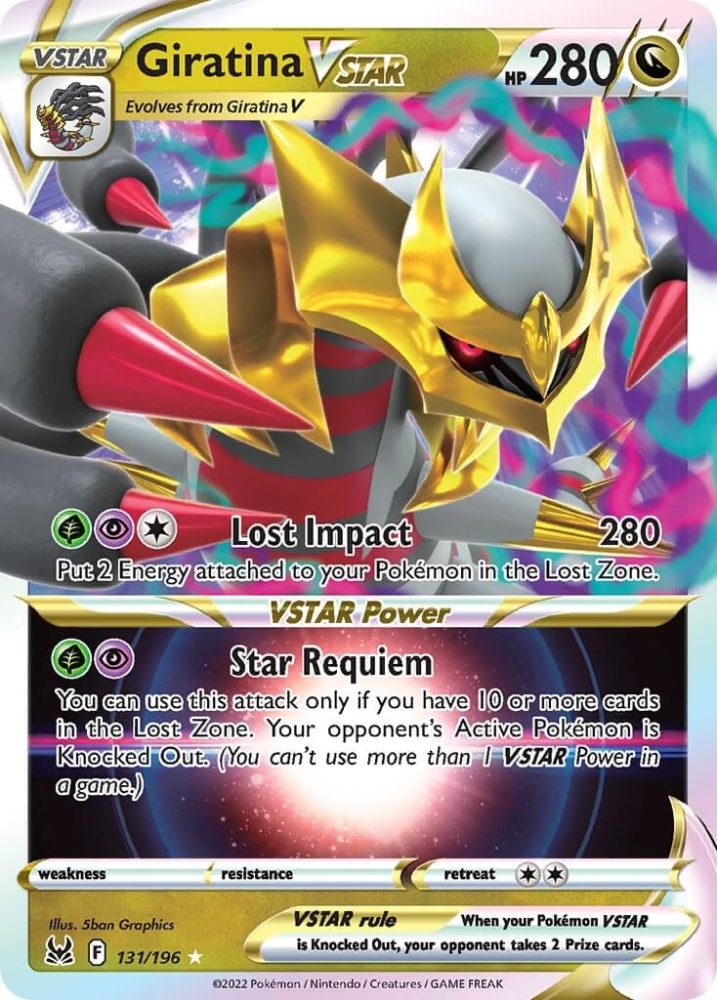
Giratina VSTAR has had its ups and downs. When the 2023 rotation happened, Giratina VSTAR was hyped as one of the best decks of the new format, and it lived up to that hype… in Japan. In the Western world, Giratina VSTAR was initially fairly underwhelming, being seen as a kind of lesser Lost Box deck, at a time when Lost Box was the top archetype of the format. It had its ups and downs since then, including a top 4 finish at Worlds, but recently, it seems that a consensus has finally been reached that it’s a strong deck, maybe the best in the format, after the two most recent Regionals, in Portland in Charlotte, were won by Giratina VSTAR, in the hands of Jon Eng and Vini Fernandez respectively.
I can’t overstate how meaningful it is that the biggest Regionals of all time was won by Vini Fernandez, a Brazilian first-year senior who made a name for himself during the covid era, as he was one of the most successful players in the many online events held between 2020 and 2022. There are a number of Latin American players who are not as well known in the rest of the world, either because they don’t communicate as much with the rest of the world due to the language barrier, or because for economic (or other) reasons, they don’t travel as much as players from other regions. (Marco Cifuentes, another player who had some fantastic results in the covid era, consistently makes top 8 at major events in his home country of Chile, but hasn’t travelled much outside of it, although he’s played in Brazil in recent years, and I have to wonder if he would be hailed as one of the top players in the world if he was able to attend as many Regionals as players from other regions). Online events have brought players from different regions closer, and Vini Fernandez and his brother Gabriel (the current Seniors Division World Champion) are both shining examples of this. I’m glad that they have now both confirmed their status as world class players in prestigious events.
Vini’s Giratina VSTAR list was nothing unusual, but it’s probably the pinnacle of the deck right now.
| Pokémon | Trainers | Energy |
|---|---|---|
| 4 Comfey LOR 79 | 4 Colress’s Experiment LOR 155 | 4 Jet Energy PAL 190 |
| 3 Giratina V LOR 130 | 2 Boss’s Orders PAL 172 | 4 Psychic Energy |
| 3 Giratina VSTAR LOR 131 | 2 Roxanne ASR 150 | 3 Grass Energy |
| 1 Sableye LOR 70 | 1 Avery CRE 130 | 3 Water Energy |
| 1 Cramorant LOR 50 | 4 Mirage Gate LOR 163 | |
| 1 Radiant Greninja ASR 46 | 4 Battle VIP Pass FST 225 | |
| 4 Switch Cart ASR 154 | ||
| 3 Nest Ball SVI 181 | ||
| 2 Pokégear 3.0 SVI 186 | ||
| 2 Super Rod PAL 188 | ||
| 1 Counter Catcher PAR 160 | ||
| 4 Path to the Peak CRE 148 |
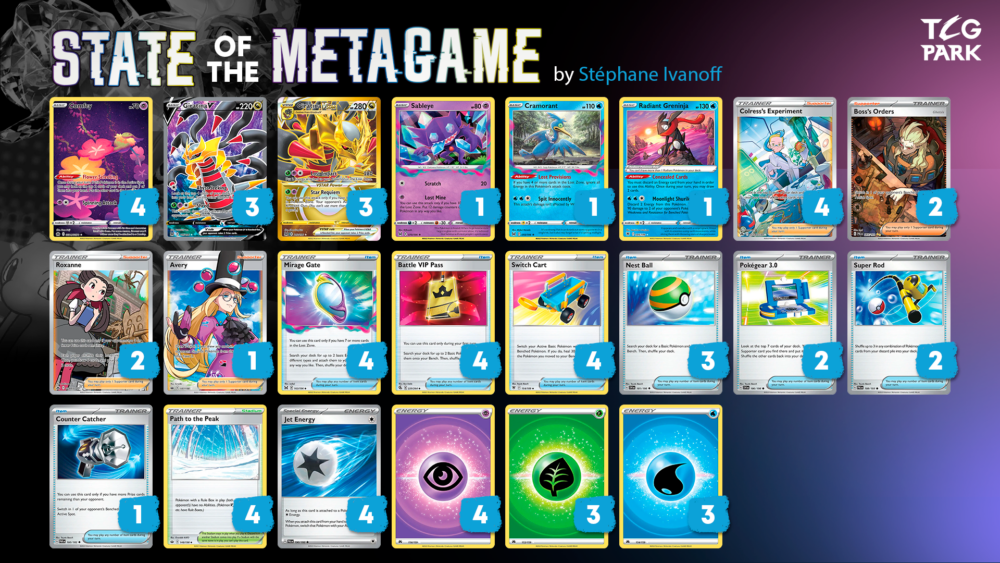
This list simply has all the good cards that Giratina may want. The 3rd Water Energy makes Radiant Greninja an actual threat rather than a pipe dream, which is relevant in the mirror match. (In other matchups, opponents will bench Manaphy, making Greninja unusable.) Avery is not strictly necessary, but it’s a good tech for some matchups, mostly Gardevoir ex and Mew VMAX. The fourth Path to the Peak is also strong against most of the metagame, especially Charizard and, once again, Mew. (More Path to the Peak is also good against Rapid Strike, which might become more relevant in upcoming events.) It’s notable that Vini only played four Switch Cart (in addition to the Jet Energy) as switch outs. Alberto Conti already demonstrated the validity of this choice, making top 8 at both Lille and Stuttgart Regionals, but many players were still hesitant to cut the fifth switch out. I’m assuming that after Charlotte, most players will accept that it’s enough; in fact, I think that this list will become the standard. I can’t really think of anything I’d change, myself: sure, Avery and the fourth Path to the Peak are not strictly necessary, and running a fourth Nest Ball could be an option instead, if you value consistency more than anything, but that’s basically it.
Roaring Moon’s Actual Rise

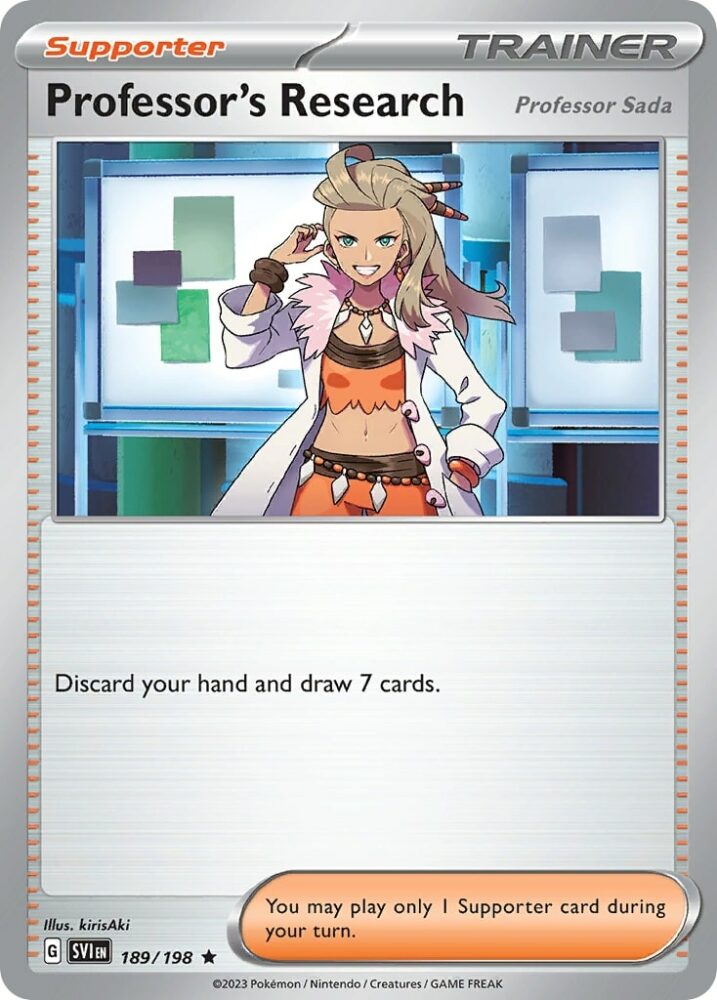
The main surprise in Charlotte was Roaring Moon ex being played more than ever. It was the fourth most played deck in the tournament, and it had a strong conversion rate, making it the third most played deck in day 2 (behind Giratina and Charizard). Even in day 2, it fared well: Ross Cawthon made top 8 with it, while two other players reached top 16.
It makes sense. With Giratina VSTAR taking first and second place in Portland, Mew VMAX could be expected to see more play, and Roaring Moon ex is one of the best answers to it, while also being good against Giratina VSTAR. It also has even or better matchups against a good portion of the metagame. Its main bad matchups are Gardevoir, which has been in a slump lately, and Lost Box, which didn’t see much play in Charlotte.
Part of Roaring Moon’s success is also the rise of a new version that relies on Professor’s Research as its main draw supporter, rather than Professor Sada’s Vitality. Ross Cawthon got 33rd in Portland with this kind of decklist, and after tweaking it a little, he made top 8 in Charlotte, proving it was no fluke; Blake Eure got top 16 with a similar list. Here’s Ross’s decklist:
| Pokémon | Trainers | Energy |
|---|---|---|
| 4 Roaring Moon ex PAR 124 | 3 Professor’s Research SVI 189 | 9 Darkness Energy |
| 2 Galarian Moltres V CRE 97 | 2 Professor Sada’s Vitality PAR 170 | |
| 1 Morpeko PAR 121 | 2 Boss’s Orders PAL 172 | |
| 1 Mew ex MEW 151 | 1 Iono PAL 185 | |
| 1 Squawkabilly ex PAL 169 | 1 Judge SVI 176 | |
| 1 Radiant Greninja ASR 46 | 4 Battle VIP Pass FST 225 | |
| 4 Dark Patch ASR 139 | ||
| 4 Energy Switch SVI 173 | ||
| 3 Trekking Shoes CRZ 145 | ||
| 3 Ultra Ball SVI 196 | ||
| 2 Earthen Vessel PAR 163 | ||
| 1 Pal Pad SVI 182 | ||
| 1 Switch Cart ASR 154 | ||
| 2 Forest Seal Stone SIT 156 | ||
| 1 Escape Rope BST 125 | ||
| 2 Ancient Booster Energy Capsule PAR 159 | ||
| 1 Emergency Jelly SIT 155 | ||
| 3 PokéStop PGO 68 | ||
| 1 Town Store OBF 196 |
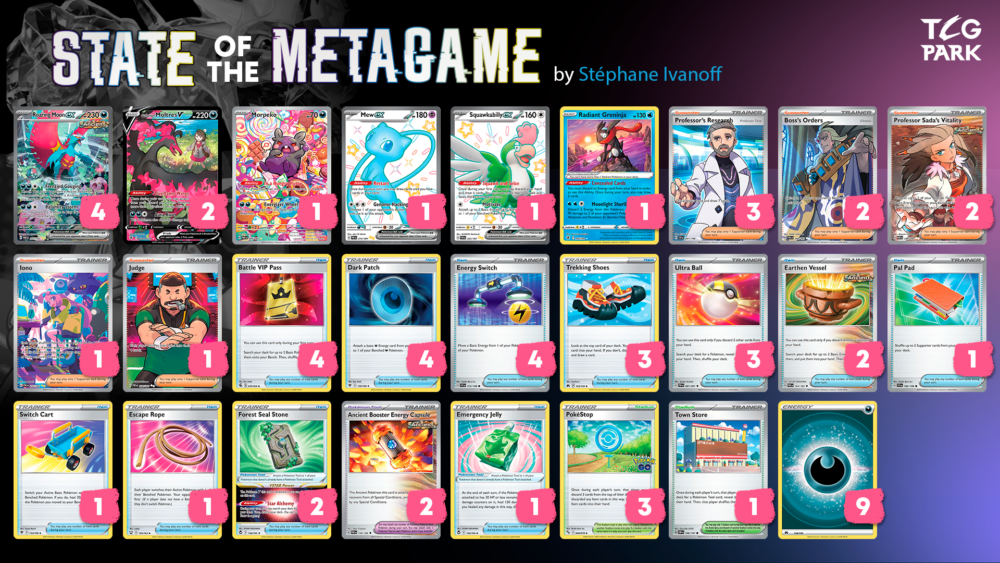
Professor’s Research adds a lot of draw power to the deck, so even though you don’t get the guaranteed Energy acceleration from Sada, you can still get multiple Energy in play thanks to Dark Patch and Galarian Moltres V (with Energy Switch). Having a better draw Supporter, especially with Pal Pad, also gives the deck more resilience against Iono in the late game.
The deck also runs Ancient Booster Energy Capsule and Emergency Jelly as powerful Tool cards which can give Roaring Moon ex a bit more survivability. Energy Capsule is generally better, since it’s more universal, but Emergency Jelly is useful in some specific matchups, notably against Charizard; it allows Roaring Moon to heal up to 150 HP after using Frenzied Gouging (a common attack in the matchup), so it can’t be revenge KO’d by a Charmander. Energy Capsule wouldn’t help in this scenario as the Charizard player can simply Lost Vacuum it away, putting Roaring Moon back at 30 HP.
Despite running multiple Item cards and more Supporters than a turbo Roaring Moon build, this list still makes use of PokéStop, which I’m somewhat wary of. That said, having Trekking Shoes in the list helps make PokéStop a better play.
Roaring Moon ex’s rise could have interesting implications for the format. For example, it makes Rapid Strike a worse choice, despite an otherwise good matchup spread (outside of the dreaded Mew VMAX matchup).
Lost Box or Gardevoir?
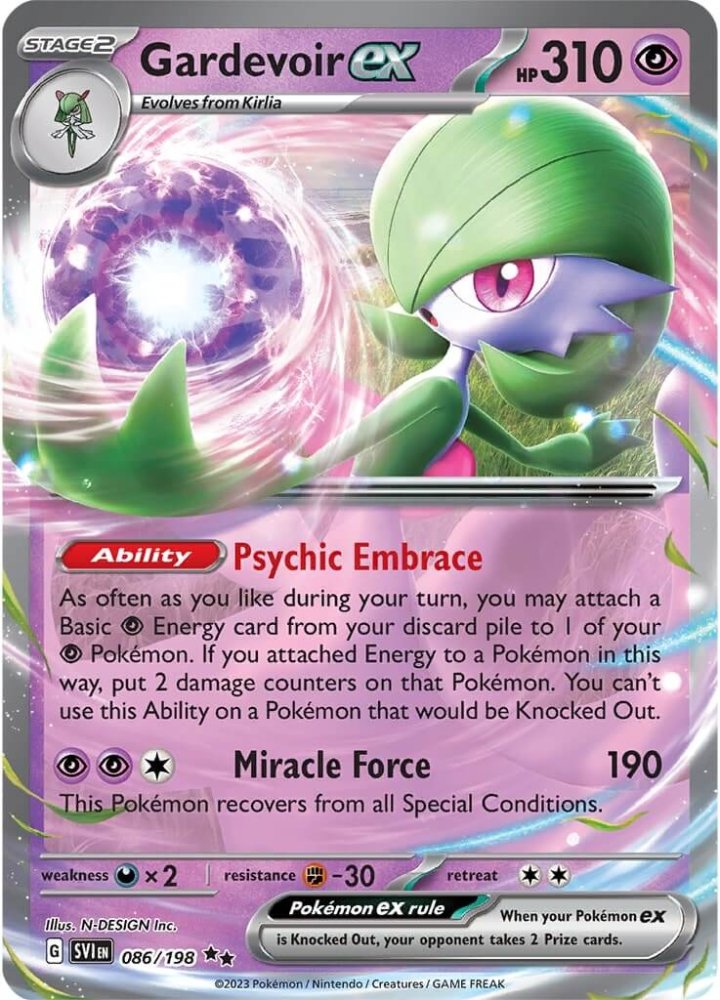
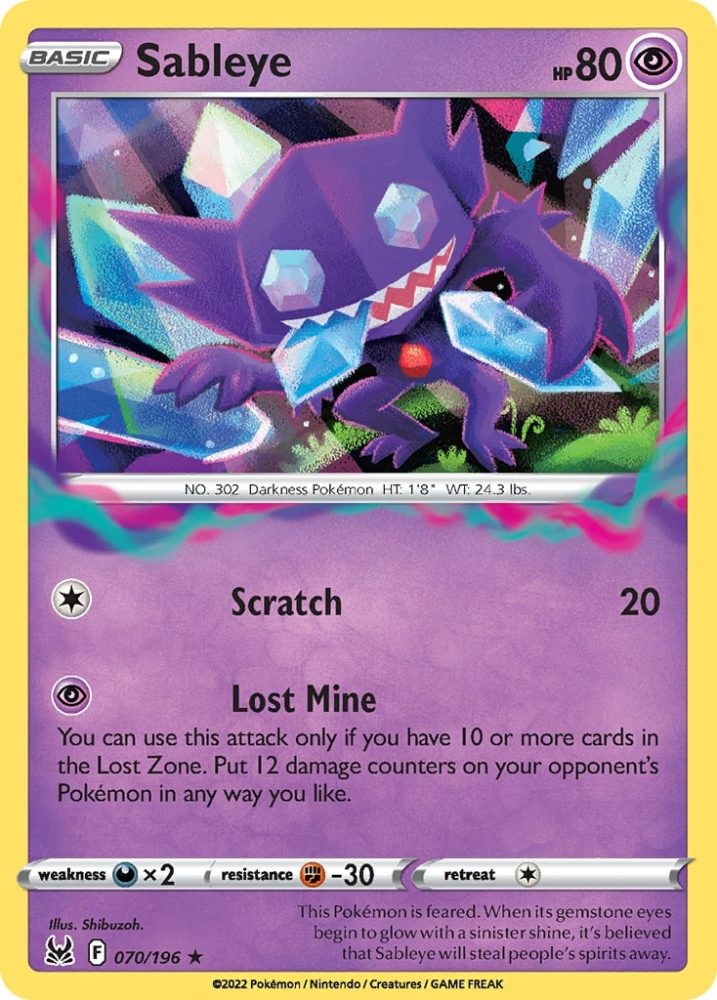
Ever since LAIC, Gardevoir ex has struggled to maintain its dominance over the format. It’s always been a good deck, but it hasn’t always made top 8, while other decks such as Miraidon, Charizard, and recently Giratina have generally been considered better choices. Recently, though, Miraidon, one of Gardevoir’s worst matchups, has been in a slump, due to unsatisfying matchups against popular archetypes like Charizard and Mew. This could be the opportunity that Gardevoir needs to rise again; we’ve seen it make top 4 at both Portland and Charlotte Regionals. It also has a good matchup against the newcomer, Roaring Moon; even Roaring Moon decklists which includes techs like Water Energy and Cancelling Cologne (for Radiant Greninja), or Iron Hands ex, tend to suffer from a loss in consistency and aren’t reliable Gardevoir counters.
The Gardevoir vs Giratina matchup has been the topic of heated discussion and, recently, a widely-publicized money match between Isaiah Bradner and Jake Gearhart. Isaiah, playing Giratina, was able to defeat Jake in a best of nine series; however, it must be noted that Jake was playing his unusual Deoxys VSTAR tech. Isaiah piloted Giratina again in Charlotte and got to play this matchup against in top 8. This time, though, he lost to the Gardevoir player, Gustavo Wada, who was running a more aggressive decklist, with two copies of Professor’s Research. Then, Gustavo went on to lose to another Giratina player, his countryman Vini Fernandez, in the semifinals. In the end, there’s no definitive answer to this matchup, but one thing is clear: if you’re running Gardevoir ex to counter Giratina VSTAR, you’d better playtest the matchup heavily. It’s definitely not a case of one deck simply beating the other. (Also, this matchup tends to tie a lot in a tournament environment, because both decks take a lot of time and reflexion to play and have the ability to come back from a Prize deficit, so early scooping is rare.)
Perhaps a better way to deal with Giratina (and one that I expect in higher numbers in Liverpool) is Lost Box. There are two main Lost Box variants: SableZard which, as Alex Schemanske (who made top 8 with it in Charlotte) puts it, beats the whole meta apart from Gardevoir and Rapid Strike; and Lost Parabox, which isn’t as consistent but has the benefit of powerful options like Iron Hands ex’s Amp You Very Much. Giratina can struggle in the Prize trade against both variants; in particular, lists without Manaphy can be hurt by Kyogre in the late game.
In my opinion, these two decks are likely to see more play in the upcoming events. Of the two, Lost Box strikes me as the most versatile, but Gardevoir does tend to have the advantage in the direct matchup, thanks to Manaphy and Jirachi.
Quick notes and conclusion
Apart from Giratina VSTAR, Charizard ex is the other top tier deck in the format, as evidenced by its consistent results; it got 2nd place again in Charlotte. Giratina’s success could play in its favor, if players focus on it more and cut their anti-Charizard techs like Technical Machine: Devolution. Giratina’s popularity may also scare away the Snorlax players, which is a huge benefit for Charizard.
Miraidon and Mew may not have had the same flashy results recently, but they’re still both very consistent archetypes that can’t be underestimated. Miraidon made top 4 again in Charlotte, and Fusion Mew started the event 9-0 in the hands of Xander Pero before being stopped by a combination of bad draws and unfavorable matchups. While neither of these decks seems to be at the height of its glory, they’re both still strong enough that I would certainly not be surprised to see them win Liverpool. Gardevoir and Lost Box round up tier 2 since, like I mentioned, they seem to be in a favorable spot right now.
In tier 3, I’ve rounded up decks that, while good, may not be ideal right now. Snorlax is a very strong archetype, but its bad Giratina matchup makes it a dangerous choice in the current metagame (not to mention other matchups like Mew). Rapid Strike is very dangerous against many top tier decks, but it’s not as unexpected as it once was, and its Giratina matchup is not as good as you might think, especially when Giratina plays four Path to the Peak. Plus, it struggles against some less common archetypes, like Roaring Moon and Stall.
Finally, the release of Paldean Fates will likely not change the balance between decks very strongly, but as I mentioned in my preview [https://www.tcgpark.com/blog/a-paldean-fates-preview], Gardevoir and Lost Box are the two decks that benefit the most from new cards (Moonlit Hill and TM Crisis Punch respectively), and they’re decks that might challenge Giratina’s top spot, so we’ll have to see what happens then!